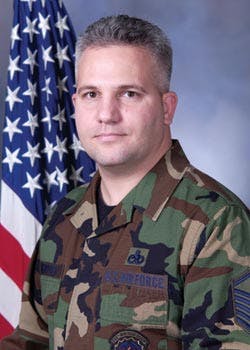Q: What was your path to AGE?
A: I enlisted in the Air Force in 1988 as an aircraft electrical systems specialist. Due to Air Force needs I was diverted to the AGE career field. I honestly did not know what AGE was about. I remember my basic training instructor telling me I would be fixing toasters. As I began to learn the numerous systems I would be responsible for maintaining, I knew I would enjoy growing as an AGE Ranger. It’s been 18 years since that day and I would not trade AGE for any other career in the Air Force.
Q: What are your responsibilities?
A: I am the AGE subject matter expert for the US Air Force Battlelabs.As a Battlelab project officer, one of my tasks is to work close with the industry to harvest ideas and search for new technologies pertaining to ground support equipment. I then prove the military worth of those ideas with the goal to rapidly get new technologies in the hands of our warfighters so they can efficiently do their job to complete the mission. Along with these responsibilities also comes reward. This job has given me an insight as to how AGE “works” in the Air Force. My job puts me in constant contact with the governing bodies of the career field. I work closely with the policy makers at Air Staff, the equipment functional manager from each Major Command and the program offices at the Logistics Center ensuring they are kept abreast of the technologies available from industry. I have had to learn the acquisition and contracting pieces of the puzzle so I can understand the cradle to grave process for putting a piece of AGE on the flightline.
Q: What are some of the day to day challenges you encounter?
A: My hardest challenge is getting out and letting industry know who I am and what I do for the military. Civilians often see a person in uniform and think we are recruiting for service. I try to approach them via trade shows and newsletters to let them know I am interested in what they have to offer the military ground support equipment maintainer. Another big challenge is standardization of equipment. New weapon systems drive a requirement for airframe specific AGE. The challenge is to standardize AGE across all the airframes while meeting the needs of specific weapon systems.
Q: What are some of the changes/trends you have seen in AGE?
A: The one change that sticks out above the rest is over the years we have had to learn to do more with less. Reduction of personnel and budget cuts along with the increase in equipment use forced us to work harder with what we got. Another change is the new AGE hitting the flightline. The life cycle of some of our AGE has is making it unsupportable so “next generation” equipment is being introduced to the field. Also, our training program for new AGE personnel as well as those in upgrade status has improved dramatically over the years. The AGE schoolhouse has made vast improvements with hands on trainers that were not present back when I went through the school at Chanute AFB, IL.
Q: Has the war changed your operations?
A: I don’t think there is a career field in the military that hasn’t had their operations affected by the war. Most notably in the AGE world is that our operations tempo has increased dramatically. This means we are using the equipment more and mean time between failure decreases. As a Battlelabber, this makes my job of finding new equipment and technologies for the AGE technicians all the more important. Hat’s off to all of our Airmen for their dedication and resolve in these times.
Q: What is your most memorable moment in the industry?
A: I have many memorable moments as an AGE technician. Living in and visiting foreign countries, getting an incentive ride in an F-111F Aardvark, briefing congressmen and senior Air Force leaders on AGE initiatives are a few. The transition from the Cold War to participating in Operation DESERT SHIELD/STORM really stands out. I went from training to defend my home station from Soviet aggression to actually putting power on aircraft that were attacking Iraqi targets. Working with the industry to prove the worth of a conceptual piece of AGE and watching it go from an idea to a fielded unit is probably the best feeling I have had as an AGE troop.





